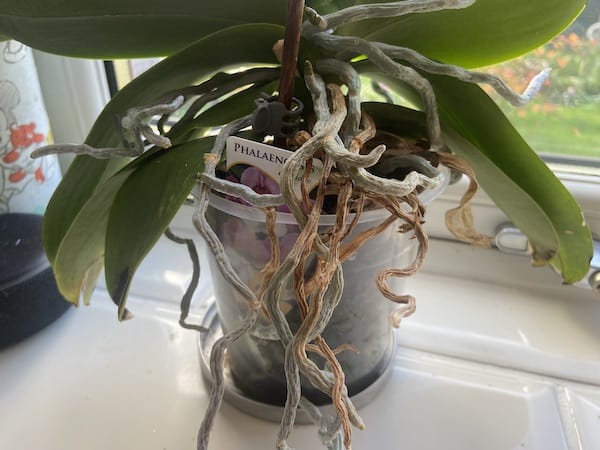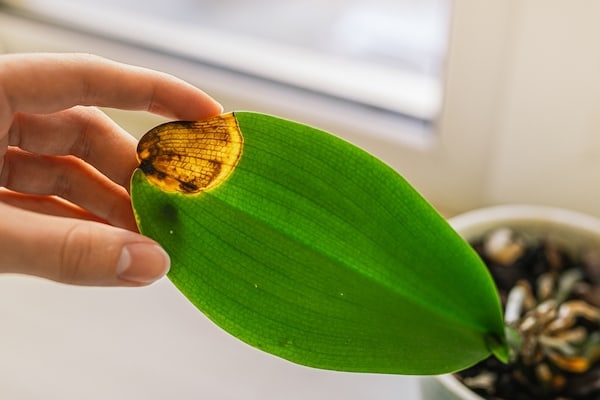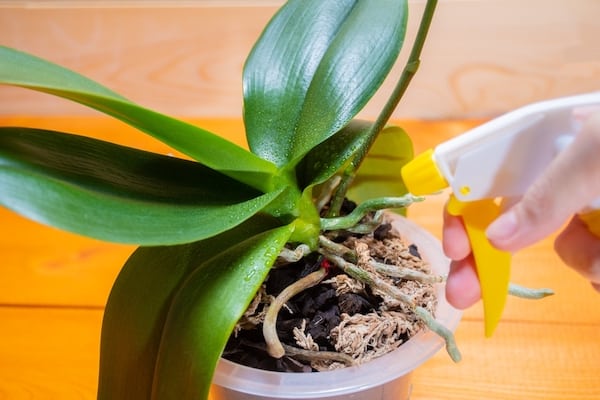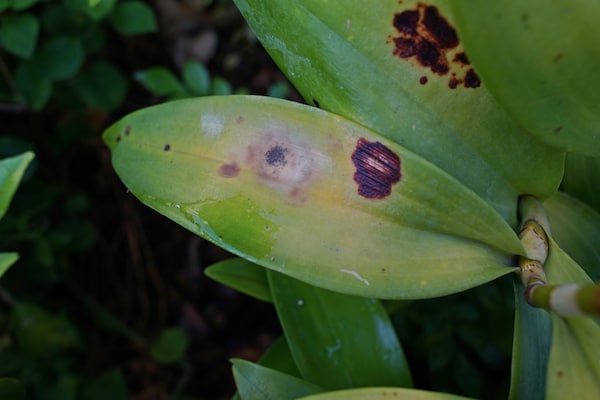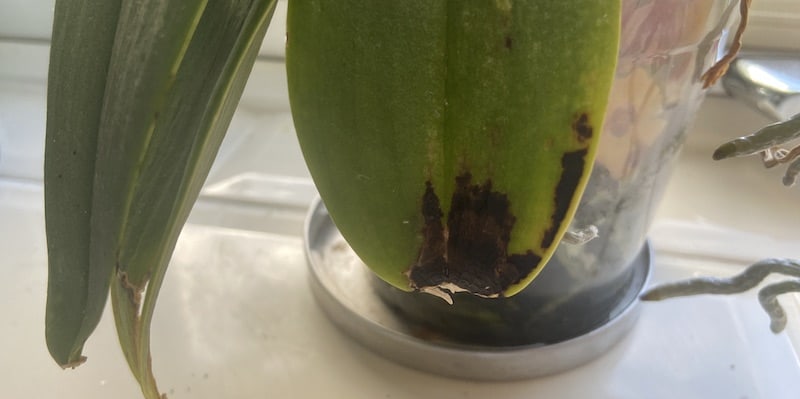
Why are my orchid leaves turning brown?
Our site is reader supported, this means we may earn a small commission from Amazon and other affiliates when you buy through links on our site.
As with orchid leaves turning yellow, orchid leaves turning brown can be due to a variety of problems. The key to narrowing down the real issue, whether it’s environmental, a care issue, pests or disease, is to notice where the leaf has turned brown. And if it’s just the older leaves or the newer ones as well. This guide helps you become the detective you need to be to identify and solve these problems.
I start with what I think is probably the most common problem, which is underwatering:
Under-watering
Under-watering your orchid plant leads to its dehydration. Without enough water, the leaves first turn yellow and then brown. This affects the entire leaf and not just the sides or leaf tips. On its way from yellow to brown, the leaf becomes leathery and limp, looking wilted.
Under-watering affects both older and newer leaves – everything is not receiving enough water.
What to do
First of all, give your orchid plant a good watering to restore the balance. See When and how to water my orchid for detailed information about the best way to do this. The article also gives information on how to create a healthy watering schedule for future care.
You also need to see if you’ve done permanent damage to your plant. Unpot the orchid and look at the roots. Healthy roots are green and plump, while dying roots are black and dry or brown and mushy. They’re not healthy enough to send water up to the plant, no matter how much you give the orchid.
Cut off the bad roots with a sterilised cutting tool. Loosen up the orchid potting mix (you did use special orchid potting mix didn’t you?) in case it’s compacted too much and is squeezing the roots too tightly. Run water through the potting mix and check that it drains out immediately. If it doesn’t then the mix is too tightly compacted.
The brown leaves will continue to fall off the plant. Those leaves with just a hint of brown will remain on the plant but will still have the brown spots to remind you to water more often in the growing season.
Build-up of minerals
Brown leaves on orchids can also be due to a build-up of mineral salts. This could be because of the minerals in the water you’re using to water your plant. Hard and soft water can have different effects on your orchid as well. The browning of your orchid leaves in this case starts at the tips of the leaves. If you notice this and address the problem early, the brown discolouration does stay there.
Or the issue could be due to over-fertilising or using the wrong fertiliser. This results in a build-up of mineral salts that may be seen as tiny crystals on the top of the orchid potting mix. The older leaves are the ones most affected by over-fertilising. They initially turn brown at the leaf tips and then go to a bright yellow before dying and falling off.
What to do
I always recommend using rain water if possible to water plants. This has a more neutral pH (acid/alkaline level) than tap water and doesn’t have the same chemicals in it. Or boil tap water before using it and let it cool down.
Always use a fertiliser made especially for orchids and apply it sparingly. Regular houseplant fertiliser is much too strong for these plants. Elsewhere I recommend that you use it on every fourth watering during the growing period.
Sunburn
Like human skin, orchid leaves burn in direct sunlight. Orchids need between six and 12 hours of indirect sunlight a day. Direct sunlight, especially over the midday hours, can cause sunburn to the plant.
Orchid sunburn starts as pale-yellow patches then turns white and then brown or black. The leaves at the top of the plant are the ones that show signs of sunburn; the leaves at the bottom of the plant escape this problem.
But it’s not just direct sunlight that can burn your orchids. A draft of hot dry air from a heating vent under or near the plant has the same effect.
What to do
Examine the location of your orchid plant and determine if it is in the path of direct sunlight or hot air flows. Move it to a more suitable place.
If you don’t have a windowsill or table near enough indirect light, read the Light section of How to grow and care for orchids for details on introducing artificial light into their lives.
Not humid enough
Orchids are tropical plants and, although they’ve been selectively bred for many years, they still prefer a humid environment. They need moisture in the air which doesn’t always happen in the UK, especially indoors in the winter with the central heating on.
A lack of humidity – around 40% in general is best – causes the leaves to turn brown and to crumple up. But that’s after the roots that are in the air become crunchy, wither and die. Then the leaves lose any shininess and turn brown and lifeless.
What to do
Increase the humidity of the environment around the orchid plant in one of several ways. You could install a humidifier in the room, but not in direct line of the plant. (Remember, keep breezes away from the orchid.)
Or you could place the orchid plant pot on a tray of pebbles standing in water. This moistens the air around the plant. But be sure the water doesn’t touch the bottom of the plant pot as that will throw your watering regime off.
Not enough nutrients
As the opposite problem to over-fertilising, the brown leaves may be because the orchid plant isn’t getting enough nutrients. This is particularly the lack of phosphorous and magnesium. This is a problem that slowly turns the leaf brown over a number of months.
If the leaf is a reddish-brown, that’s the absence of phosphorous. If brown spots appear that look like rust, that’s because there’s not enough magnesium.
What to do
Check that your plant fertiliser includes these nutrients in the right amounts. Use a fertiliser especially formulated for orchids.
Examine the roots of the orchid plant to ensure that they’re not tightly tangled together and prevented from distributing the fertiliser throughout the plant. Repot the orchid plant if needed to give the roots more space to breathe.
Pests and diseases
Various pests, such as scale insects and diseases such as root and stem rot can turn the leaves on your orchid brown.
What to do
I have a detailed article called Orchid pests and diseases that covers the most common problems in these areas. It also directs you what to do when you encounter one (or more) of these problems.
